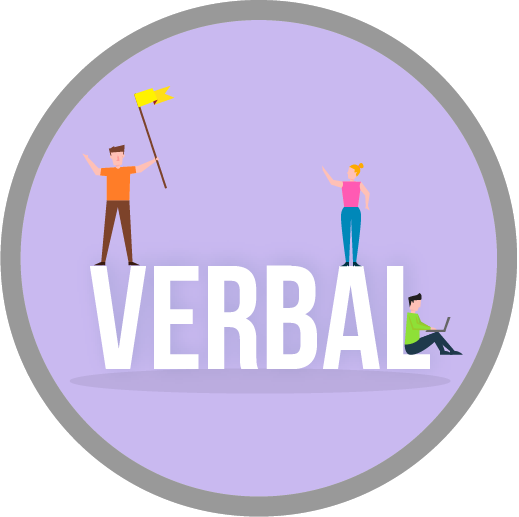GRE® Preparation
The Ultimate Guide
If you are looking to apply to master’s courses abroad through the GRE®, you’ve reached the right place. Treat this as your ultimate guide to preparing adequately for a high score on each section of the test.
Make no mistake - this isn’t one of your generic online articles that are all froth and no substance!
We have included important strategies that can really help you boost both, accuracy and speed, so if you’re really looking to up your GRE® game, you’ll find this immensely helpful!
Don’t have time to read the whole guide right now?
No worries. Let me send you a copy so you can read it when it’s convenient for you. Just let me know where to send it (takes 5 seconds)
Contents
Chapter 1
What is the GRE® & how is it structured?
The GRE® is the most widely accepted test for graduate admissions in graduate and business schools worldwide. It is conducted by the Educational Testing Service, often referred to as the ETS. The test can be taken both online (CBT - Computer Based Test) and offline (PBT - Paper Based Test). However, the Paper-Based Test is available only in those countries where the Computer-Based Test is not supported. In India, the CBT is conducted at several Prometric and non-Prometric test-centers at most major cities.
Note that the GRE® is more of a test of your analytical skills than your technical knowledge and has 3 sections, Verbal Reasoning, Quantitative Reasoning and Analytical Writing Assessment.

For offline/online test centers and booking, click here.
There is no common question paper or even a set of question papers for GRE® preparation. Rather, there is a database of test questions of assorted difficulty levels. The GRE® is an adaptive style test, which means that your performance on the first section determines the difficulty level of the second. For example, if your answers to the first set of questions are mostly correct, then the difficulty of the next set of questions would be higher, and so on. However, if you scoreless in the first section, the difficulty level of the subsequent section will be reduced. The test-takers start with questions of average difficulty level. Except for the first part of the test, the rest of the sections adapt according to the knowledge quotient of the test taker. There are three sections in a GRE® test paper:
Quantitative Reasoning Sections (Quants/Maths Section)
This section comprises questions of high-school level in geometry, algebra, arithmetic, applied maths, data interpretation, and data analysis. There are 2 Quantitative Reasoning Sections, and in each, students have to answer 20 questions within a duration of just 35 minutes. That's a total of 40 questions in 70 minutes.
The six topics to be covered for this section are Arithmetic, Algebra, Geometry, Data Analysis, Applied Maths, and Data Interpretation.
Verbal Reasoning Sections (English Section)
The intent of GRE® Verbal Reasoning is to test your ability to comprehend written text, form conclusions and figure out relationships between two or more parts of a sentence. There are 2 sections of 20 questions each, including topics like reading comprehension, text completion & sentence equivalence. You get 30 minutes to answer each section of 20 questions.
The concepts tested by this section include your logical reasoning abilities apart from your knowledge of English grammar, synonyms, antonyms and overall vocabulary.
Analytical Writing Assessment (AWA)
This is an important, but often overlooked aspect of GRE® Preparation. The AWA measures the critical thinking ability and analytical writing skills of a candidate. This section intends to test your ability to form a convincing theory and how persuasively and coherently you defend it over the course of several paragraphs. You are required to frame 2 essays in an hour, with roughly 30 minutes to devote to each:
Issue-Based Essay
This question would test your convincing skills. Its topic will be based on a general everyday issue, and you would be required to express your view on the said topic. You should provide sound reasoning to support your views and use examples to make your point.
Argument-Based Essay
This question would require you to pick a side (for/against) and then explain your choice through a written response.
eBook: The Introduction to GRE
Chapter 2
What is a good GRE® Score?
What exactly is the ideal score you should be targeting on your GRE? Well, the score is divided into three categories: excellent, good and modest. Depending on the history of selection in your desired course, at the universities you are applying to, you can set a target GRE® score for yourself. You can also try the free GRE® score predictor to see how much you'd score on the GRE® if you took it today! The feedback that you get along with it can really help you plan how much effort you need to put into each topic to prepare for your target score. Note that for most master’s programs in STEM (Science, Technology, Engineering, and Math) fields, universities prioritize applicants with higher Quants scores, so try aiming for a perfect or near-perfect score on this section.

Scores to target on each section:
To be among the top 10%, the score you should be aiming for is a 328 or above, with a 5 on the AWA.
| AWA Section | 5.0+ |
| Verbal Section | 163+ |
| Quant Section | 165+ |
For being amongst the top 25% of the GRE® scorers, the score-range you should be aiming for is 317-327
| AWA Section | 4.5+ |
| Verbal Section | 158-162 |
| Quant Section | 159-164 |
For being amongst the top 50% of the GRE® scorers, the score-range you should be aiming for is 305-316
| AWA Section | 4.0+ |
| Verbal Section | 152-157 |
| Quant Section | 153-158 |
Source: What exactly is a good GRE® score | GREedge Blog
And here are the GRE® cutoffs of the top ten schools in the US:
| University | Average GRE® Score (Verbal + Quant) |
|---|---|
| Massachusetts Institute of Technology | 325 (160+165) |
| Stanford University | 327 (160+167) |
| University of Berkeley | 323 (157+166) |
| California Institute of Technology | 328 (160+168) |
| University of Michigan, Ann Arbor | 321 (155+166) |
| Carnegie Mellon University | 323 (156+167) |
| Purdue University | 320 (155+165) |
| Georgia Institute of Technology | 320 (156+164) |
| University of Illinois, Urbana-Champaign | 327 (157+167) |
| University of Southern California | 317 (151+166) |
Check out the GRE® cutoffs for the Top 35 US universities in this eBook
As we can see, every single university but one has an average requirement of at least 320, so anything above 320 could be considered a good GRE® score.
What is a good score to target on each section?
The following table shows the GRE® scores of students at different countries(2017). Data shows that Indian test takers on average, tend to fall behind on the AWA and Verbal sections, but perform relatively well on the Quants section. So if you are just getting started with your GRE® preparation, the Verbal section can become your key area of focus.
| Country | Number of Test-Takers | Verbal | Quantitative | Writing |
|---|---|---|---|---|
| USA | 3,21,228 | 152.6 | 150.2 | 3.9 |
| India | 80,123 | 145.5 | 155.3 | 3.1 |
| China | 58,679 | 148.5 | 164.7 | 3.1 |
| S. Korea | 6,030 | 150.1 | 160.5 | 3.3 |
| Canada | 5,505 | 156 | 154.6 | 4.2 |
| Brazil | 1,769 | 150.7 | 152.7 | 3.1 |
| Germany | 1,431 | 154.5 | 157.1 | 3.9 |
Source: GRE® Worldwide Test Taker Report | ETS
Here are the stats of test-takers in the period 2014 - 2017:
| Test | Number of Test-Takers | Average Score |
|---|---|---|
| Verbal Reasoning Measure | 17,27,225 | 150.05 |
| Quantitative Reasoning Measure | 17,30,288 | 152.80 |
| Analytical Writing Measure | 17,22,231 | 3.50 |
Source: GRE® General Test Interpretive Data | ETS
Like in just about any exam, the smart strategy would be to play to your strengths while also ensuring to brush up your weaker areas with regular practice. Thus, if you’re an engineering or maths/science graduate who’s more comfortable with numerical problems than with GRE® level reading comprehension or vocabulary, you should Ideally aim for a perfect 170 on the Quants section and 160+ on GRE® Verbal.
eBook: What exactly is a good GRE® score?
Chapter 3
How long does it take to prepare for the GRE?
While there’s no hard and fast rule, an analysis of GREedge students shows that the majority of 320+ scorers spend 60 days on their GRE® Preparation, as you can see in the graph below:

But we can also see that the 2nd largest chunk of students prepared for the same score in less than 30 days - a remarkable feat indeed! So how did they plan their GRE® preparation in such an effective manner? Let’s find out!
Daily time allocation to GRE® preparation (Quants & Verbal)
- 1 hour 15 minutes for the Quantitative section: Cover one topic for 45 -60 minutes then take a test for 20-30 minutes. Carefully review the mistakes made after the topic based test.
- 1 hour 15 minutes for the Verbal section: Half of this time should be spent on Reading Comprehension. Learning 30 words a day for a good GRE® vocabulary.
Of course, the effectiveness of your preparation is not just about how much time you devote to learning and practicing, but also on how efficient and organized your study-plan is! Which brings us to our next, and one of the most important topics.
Chapter 4
Crafting a personalized study plan
Organized and consistent practice is of utmost importance and hence, a study plan that revolves around your time availability, target score and current level of preparation is something you need to set up even before you start preparing for the GRE®.What should your study plan be based on?

Your current skill level: Your current skill level is essentially what you’d score on the GRE® if you were to take it today! This can easily be mapped by a diagnostic test that mirrors the structure and pattern of the actual exam. Depending on how much you already know about the GRE® syllabus and question pattern, the time you’ll need to prepare for a 320+ score might vary.
Take a look at how much you’d score on the GRE® if you took it today - try a free GRE® Diagnostic test now!
A closer analysis of our students who scored a 320 and above on their GRE® revealed that their average score on the diagnostic test prior to starting their GRE® preparation was 311.
Graph made using data of over 1000 students who scored 320+ on their GRE® based on their diagnostic test scores.
More interesting facts our student data threw up:
- The average score boost for students over their diagnostic test score was 13 points.
- As for students who had taken the GRE® before, the average score boost over their previous GRE® score was 9.5 points!
Depending on where you currently stand, you might need to devote more or less time to your GRE® test prep to achieve your target score, which brings us to our next point!
Your target GRE® score: It shouldn’t come as a surprise that more ambitious goals necessitate more effort, time and discipline as compared to more conservative targets! Preparing for a higher target score will require a comprehensive study plan that systematically tackles weakness areas while also building on your strengths, along with regular testing and progress evaluation!
Time allocated every day for GRE® preparation:
“Long-term consistency trumps short-term intensity” - Bruce Lee
Nothing can hold truer when it comes to preparing for an exam like the GRE!
When you’ve set aside a time period as long as 6 months for your GRE® preparation, it’s easy to lose focus early on as there is seemingly a long time ahead of you to prepare! However, it’s recommended that you devote at least an hour a day each for verbal and quants prep.
With working professionals and final year college students already saddled with work or projects and other commitments, time is at a premium; which is exactly why their study plan has to be one that doesn’t interfere with their schedule, while still getting them prepared for their target score!
Since all of the above factors are bound to vary from one student to another, it’s extremely imperative that your study plan is one that is completely personalized - tailored to your current skill levels, target score, and your time availability for effective GRE® Preparation!
Case in point: GREedge alumnus Karan Saluja.
Student: Karan Saluja
Profile: Alumnus of BITS Pilani, Working Professional at Amazon India, working 12 hour shifts
Target Score: 330
Diagnostic Test Score: 309 (V - 148 | Q- 161)
Achieved Score: 332 (V - 163 | Q - 169)
Where the real problem for Karan lay, as demonstrated by his diagnostic test results, was in the Verbal section - specifically in reading comprehension, GRE® vocabulary, text completion and sentence equivalence.
Moreover, as a professional working 12-hour shifts, his work timings necessitated a study plan for highly effective GRE® preparation that covered all the required areas in a way that didn’t interfere with his schedule.
Accordingly, a study plan for Karan was drawn up by his trainers that focused on bringing his areas of weakness up to speed first, before brushing up the remaining areas.
Take a look at Karan’s study plan for the first month, below:
table here
So if you’re wondering whether a busy schedule can come in the way of a high score, it’s nothing that can’t be solved with the help of a well-structured GRE® Preparation study plan, woven around your existing commitments without interfering with them.
Download free eBOOK: The perfect 30-day study plan for a 320+ score
You can follow the following steps to make a study plan for ensuring that your GRE® Preparation is completely tailor-made to suit your needs:
Step 1:Take the GRE® diagnostic test and determine your strengths and weaknesses
Step 2:Take topic wise tests to map your progress on each section, followed by full-length tests that closely mimic the pattern and difficulty level of the real GRE®.
Your daily GRE® Preparation target should include:
- 1 hour 15 minutes for the Quantitative section: Cover one topic for 45 -60 minutes then take a test for 20-30 minutes. Carefully review the mistakes made after the topic based test.
- 1 hour 15 minutes for the Verbal section: Half of this time should be spent on Reading Comprehension. Learning 30 words a day for a good GRE® vocabulary.
Step 3:Brush up your knowledge of AWA topics. A good AWA score can really strengthen your application, even more so if you’re applying to a research-oriented or thesis-heavy program such as a Ph.D.
Step 4:Once you have covered all the topics in all the sections, take Mock tests and at least 3 full-length online practice tests to familiarize yourself with the pattern, features and timing of the GRE® before you experience the real deal.
Now, let’s look at how to prepare for each section of the GRE® - Verbal Reasoning, Quantitative Reasoning and Analytical Writing.
Chapter 5
Planning your GRE® Preparation (Verbal)
Did you know that among the GRE® test takers from India in 2016-2017, the average score in GRE® Verbal is only 145.5 which is the 27% percentile score.

But, scoring a 160+ in GRE® Verbal puts you in the 84th percentile or the TOP 16% of the world’s GRE® test takers!
Imagine that on your university application!
What does the GRE® Verbal section contain?
The verbal section of the GRE® tests your Verbal reasoning skills in the form of three main types of questions:
- Text Completion
- Sentence Equivalence
- Reading Comprehension
Sounds simple enough?
Now, at the heart of GRE® Verbal lies another important topic that you should master i.e GRE® Vocabulary.
Though you’ll never be directly tested on these words, there are more than 3000 special words that appear in GRE® Verbal questions AND answer choices, called the GRE® words.
Knowing their meaning & context of application is essential to cracking the right answer & scoring high in GRE® Verbal.
The graph below, shows the time spent by students on the 3 topics of Verbal section. Most of the time of potential test takers was spent on Reading Comprehension (RC). It actually is okay because 10 out of 20 Questions of this section would be based on RC Passages. Text Completion (TC) and Sentence Equivalence (SE) comprise the rest of the questions.
Verbal Stratagies
1) GRE® Verbal Strategies For Text Completion
- In Text Completion, you will have to complete the sentence by choosing the correct answer for the given blanks.
- One of the constant sources of __________ concern for most governments is that of tax evasion. The problem lies in the fact that as a taxpayer, you know what your income is, but the revenue collector does not. So you have an incentive to __________ your income report.
- A) ethical
B) legal
C) fiscal
D) manipulate
E) be truthful of
F) estimate - In your GRE®, you can expect three types of Text Completion questions:
- 1. Single-Blank
- 2. Double-Blank
- 3. Triple-Blank
- While you might think that practice is the best way to score in TC, the actual data shows that students spend maximum time learning important concepts to crack Text Completion. Especially topics like: Sentence construction Identifying contextual & structural clues Building a strong vocabulary
- If you’re curious to understand what these topics are and how to apply them, check out the FREE eBook packed with Sample Questions & Solved Examples called, The Ultimate Guide To GRE® Verbal
2) GRE® Verbal Strategies For Sentence Equivalence
- A Sentence Equivalence question also looks like a Text Completion question, except that you have to choose 2 options that convey the meaning of the sentence when used in the same blank.
- That’s why, both of these sections of the GRE® Verbal require you to have a strong understanding of how sentences are constructed.
- However, the differentiating factor with respect to Sentence Equivalence lies in the amount of practice you put in.
- For example, let’s take a look at this GRE® Style SE Question!
- We know that water is our potential __________ since it is widely agreed that if there is another World War, it would be waged over this precious resource, ironically there is very little we know of this essential source of life.
- A) nemesis
B) relief
C)affliction
D) antagonist
E) manipulator
F) competitor - What's your guess?
- The correct answer is actually Option A & Option C
- Why?
- If you read the sentence very clearly, it says that “Everyone knows that if there was another world war, it would be fought over water. It plays such a big role in our lives. Yet, ironically, we do not know much about water.”
- Now, look at the given context clue in the sentence - "SINCE"
- “since it is widely agreed that if there is another world war, it would be waged over this precious resource”
- In simple terms, the sentence means, "Since water is so precious that it can become the root of all conflicts." So, the blank we’re looking for should mean something that is related to conflicts. To choose the right options, it is important to know the meaning of the words.
- Nemesis: The cause for someone’s or something’s downfall.
- Water has been described as the most probable reason for the next world war. Therefore, this word definitely fits the blank.
- Affliction: Something that causes pain, damage or harm.
- Synonym Alert! This word could surely fit as water is a precious resource that can be the root cause for the next world war, causing great devastation.
3) GRE® Verbal Strategies For Reading Comprehension
- Ask any GRE® aspirant, what’s the one section that they are worried about, and the answer is always GRE® RC. This is especially amplified by the fact that GRE® RC forms 50% of the GRE® Verbal section.
| Module | Time Spent | No. of questions |
|---|---|---|
| RC | 32.64% | 10 |
| TC | 36.43% | 6 |
| SE | 10.99% | 4 |
- So, what’s the key to cracking this particular question in GRE® Verbal?
- Well, most GRE® aspirants tend to think it’s just more practice. But here’s some data that tells a different story.
- As you can see, when it comes to GRE® RC, cracking the right answer is not just about practicing concepts but also about learning how to read a passage & what to interpret from it.
- Get your ultimate free handbook on GRE® Reading Comprehension today! It contains effective techniques to solve RC questions using the Identify, Eliminate and Attempt approach, and solved examples of actual GRE® style passages.
- Download the ULTIMATE HANDBOOK for RC Preparation
- Get rid of your GRE® Verbal blues now! Watch this 10-minute video guide on scoring a 160+ in the easiest possible way!
Chapter 6
GRE® Vocabulary
Vocab Text Vocab Text Vocab Text Vocab Text Vocab Text Vocab Text Vocab Text Vocab Text Vocab Text Vocab Text Vocab Text Vocab Text Vocab Text Vocab Text Vocab Text Vocab Text Vocab Text Vocab Text Vocab Text Vocab Text Vocab Text

Verbal Stratagies
GRE® Verbal Strategies for Fast Vocabulary Building
- Learning the concepts of Text Completion, Sentence Equivalence & Reading Comprehension is one thing, but what ties it all together is your sound knowledge of the GRE’s advanced vocabulary.
| Current Skill Levels | Average Score Boost to 160+ | GRE® Words Mastered |
|---|---|---|
| Level 1 | 17 | 1849 |
| Level 2 | 11 | 1568 |
| Level 3 | 7 | 1344 |
| Level 4 | 0 | 1473 |
- Most 160+ scorers spend ample time, not just ‘seeing’ GRE® words which is only looking at the meaning & usage of the word but also in ‘mastering’ GRE® words which includes taking practice tests & regular revision.
- If you’re targeting a 160+ in GRE® Verbal & you’re currently in the 145 range in your diagnostic score,
- Just take a look at the volume of words mastered by students who scored less than 145 on their diagnostic test score, but achieved a 160+ on the actual GRE® (Verbal)!
- Download an eBOOK on How to score 160+ in GRE® Verbal by Learning GRE® Words?
- Take a look at this video on learning GRE® words to know How you can learn up to 50 words each day!
Chapter 7
GRE® Quantitative Reasoning
Scoring a perfect 170 on the GRE’s Quantitative section is something most test-takers from engineering backgrounds target. Given the fact that most questions are from concepts students learn in high-school, it’s no surprise that Indian students have a considerable edge over the global competition on this section.

What are the different types of GRE® Quant questions?
The GRE® Quantitative Section, similarly, has three sections out of which two are scored. Test-takers have 35 minutes for each section, containing 20 questions. It consists of four types of questions.
Quantitative Comparison: These questions require you to find out the relation between two quantities. You need to select one of the four answers where the choices will be as follows:
- Quantity A is greater
- Quantity B is greater
- Both the quantities are equal
- The relationship cannot be determined from the information given
Multiple choice questions: These can have one or more correct choices in the given list of 4-5 choices. Many at times it won’t be specified how many correct answers would be there, but you’ll have to mark all and only the correct options to get a full score. Remember that the GRE® does not have any partial marking system.
Numeric Entry: These questions will require you to enter the numbers in form of integers or fractions.
The general format of the GRE® quants section comprises nine problem-solving questions, eight quantitative comparison, and three data interpretation questions. Click on the link below to download a list of sample GRE® Quants questions that closely resemble ones found on the actual GRE®.
Check out our eBOOK on Sample GRE® Quants questions here
How to score a perfect 170 in GRE® Quants!
Based on data collected by GREedge, the following graph shows the time spent by students on the 6 topics of Quantitative Reasoning section. Most of their GRE® Preparation time was spent on Arithmetic and Geometry - which is pretty natural, as questions from these 2 topics form the bulk of the GRE® Quants section. Geometry is also one of the toughest topics on the GRE®, giving rise to some really tricky questions that often catch students off-guard.
Here’s how much time students at GREedge typically spent in preparing for a perfect quants score (170):
When compared to the Verbal section, it’s a lot easier to score full marks on the Quants section. However, a few silly mistakes or improper time management often hold back students from reaching a 170, even though they might be familiar with all the required concepts. Here’s how you can stay clear of them and go for the score you’ve always wanted. Just to give you a quick recap, the GRE® Quantitative Reasoning section includes the following topics and question types:
Topics
Question Types
We found that on average, students spend quite a lot of time on three main topics during their GRE® Preparation:
- Geometry
- Applied mathematics - which includes topics like Speed, Time, Distance, Work, and Venn Diagrams.
- Data Analysis
In each section comprising 20 questions, these are how many questions you can expect from each topic:
| Module | No. of questions | Difficulty | Priority |
|---|---|---|---|
| Arithmetic & Algebra | 6-8 | Easy-Medium | 4 |
| Geometry | 6-8 | Medium-High | 1 |
| Data Interpretation | 3-5 | Medium-High | 3 |
| Data Analysis and Applied Mathematics | 2-4 | Medium-High | 2 |
Though Algebra & Arithmetic are higher in volume, the difficulty level of questions is higher in the last three topics (Data Interpretation, Data Analytics & Applied Mathematics). That’s why students who score a 170/170 in Quant usually prefer to master these topics first, usually starting their GRE® preparation with them.
Here is a list of the top mistakes to avoid on the quants section if you’re looking to score BIG:
1) Not Prioritizing High-Yield Topics
- Most 170 scorers spend over 60% of the time devoted to GRE® preparation on learning, out of which the majority is spent on tricky topics like Geometry, Applied Mathematics & Data Analysis! However, if you’re preparing on a tight schedule, it’s a good idea to prepare topics that have a higher representation first, such as arithmetic, algebra and geometry. The remaining time is spent on practicing, and here too you must ensure that you practice the harder topics first, and identify where exactly you’re making mistakes. This will allow you to allot more time to learning important concepts and ensuring no knowledge gaps exist by the time you take your GRE®.
2) Falling prey to trick questions
- The GRE® Quant questions are designed to test how alert you are. Defeat these trick questions by solving more advanced questions such as Level 4 & Level 5 questions, especially from topics like Geometry, Sequences, Permutations & Combinations and Probability!
2) Falling prey to trick questions
- The difference between a almost perfect score and a perfect score lies here! Often, in a rush to finish the questions faster, students end up making easily avoidable careless mistakes even though they are completely familiar with the concepts and formulae. Check the units and signs carefully before starting your calculation and double check if you’re unsure about any step. Be sure to avoid:
- Marking an answer just because it appears in your calculation
- Choosing only one answer in a Multiple Selection question
- Rounding off incorrectly, especially in a Numeric Entry question!
4) Forgetting formulae!
- There’s nothing worse than sitting on a question, knowing you could solve it, if only you were able to rack your brains & remember the formula! Create a formula book that you update & can revise from regularly - or just download the GRE® Math Formula Book for a Perfect 170. It contains all the formulae you’ll ever need for your GRE® preparation, organized in one place.
5) Spending too much time on a question!
- If you’re tracking yourself with a watch, don’t. You’re not allowed to wear a watch to the exam. Instead, familiarize yourself with using an online timer that helps you keep track of time! If you feel you’re stuck on a single question, flag it for review and move onto the next. You can always come back to the questions you’ve flagged once you’ve attempted the rest.
- Dream of scoring a perfect 170 in Quants? Watch this video to know what every Quants top-scorer has in common
Chapter 8
Analytical Writing Assessment - Getting a 4+ Score
The GRE® exam starts with the AWA section. Although it’s often overlooked by students as it’s scored separately and doesn’t form a part of the final GRE® score, universities have a separate cutoff for the AWA score too, which usually hovers around the 4.0 mark. Your AWA score assumes special importance when applying to Ph.D. or thesis-centric programs, where you’ll be required to write a lot of well-researched, analytical content so if you’re applying to one, your GRE® preparation will be incomplete without a healthy dowse of AWA practice.

In order to score a 4 and above though, there are a set of pointers to follow. Take a look before you commence your AWA prep.
1) What is the AWA Section and what does it comprise?
Know more about the section before preparing.
- What is the AWA Section about?
- How is the AWA section scored?
- What does the AWA Section comprise?
- What is the importance of the AWA Section
2) Do you know about the issue and the argument essays?
Understand these before moving on to further preparation.
- What exactly is an issue essay?
- What exactly is an argument essay?
- What do the issue and argument tasks consist of?
3) What is the duration of essay writing?
Manage your time while practicing.
- Do you know the duration of issue task?
- Do you know the duration of argument task?
- How can you manage time to score maximum in AWA?
4) What does the AWA section test?
Understand what is expected of you.
- What does the issue section demand?
- What does the argument section test?
- What kind of AWA scores do the universities look for?
What does the issue task test?
- It tests your ability to understand and simplify complex ideas which will be needed during your higher studies.
- This section is not meant to see your knowledge on any specific content.
What does the argument task test?
- Your ability to understand, analyze and evaluate arguments.
- How you are able to convey your evaluation clearly in your writing.
How is the AWA Section scored?
- The AWA assignment is scored on a scale of 0 to 6 with 0.5 point increments.
- Your essay responses on the Analytical Writing section will be reviewed by e-rater, computerized software developed by ETS as well as by experienced essay readers during the scoring process
- If there is a difference of more than 1 point between the essay task and the assignment task, your assignment will be re-checked manually by an examiner. Otherwise, your final AWA score will be the average of the scores obtained on each task.
What is the duration of AWA Section?
- The AWA section is 60 minutes long with 30 minutes for the issue task and 30 for the argument task.
What are the different topics in the awa issue and argument essays?
- The topics for both the issue and argument tasks vary from technology, art, education all the way to politics with each containing several sub-topics. Hence, the best way would to gather as much information as possible and equip yourself with the current state of affairs.
- The good news is, the topics are always drawn from a fixed pool of around 200, which you can find on the ETS’s website. Now, though it might not be possible for you to prepare all of them individually, you’ll know the kind of topics to expect, and will have the opportunity to do your reading on the ones that you’re not too sure about.
- Click here to view the full list of issue topics and here for the complete list of argument tasks.
Parameters on which the awa section is evaluated:
- How a student develops the issue or responds to the argument given in the topic.
- Identification of the key features of the topics and how a student analyzes each of them in a thoughtful manner.
- Support of each point of critique with insightful examples and logical analysis.
- Development of ideas in a clear, organized manner, with appropriate transitions to help connect ideas together.
- Proficiency, fluency, and maturity in sentence structure, use of vocabulary, and idioms
- Command over the elements of standard written English, including grammar, syntactic variety, word-usage, spelling, and punctuation.
What are the dos and don’ts for the argument task?
- DOs - Understand, Critically analyze, Evaluate, Check for assumptions, Point them out, Logically state how the conclusion cannot be reached by the given data
- DON'Ts - Agree or Disagree with the position stated, Express your own views on the subject being discussed.
Argument task definitions for instructions
- Analysis - Breaking the whole into parts
- Evaluation - Evidence, Reasoning, Conclusion - What is the quality of the evidence? - How sound is the reasoning?
- Assumption - The belief behind maintaining a position (may be false) - Alternative explanation - Other possible causes - Counterexample- example to refute stated argument
What does each score mean?
We now know what the AWA section entails, how it is scored, and how to prepare for it. Let’s now look at what each score level means by looking at the mechanism from an examiner’s point of view - starting with a perfect 6, down to a 0.
- Six: The essay has been presented excellently. The ideas presented and the supportive reasoning points have been rendered superbly. Throughout the essay, the author has developed a coherent and logical thought-flow. The examples utilized are contextually appropriate and are employed in the right places. Overall mastery over the language is demonstrated throughout, adeptly using metaphors, figures of speech and correct idiomatic English, with no grammatical or spelling errors
- Five: The essay is a pretty compelling one! The author has been able to identify correctly the different facets of the given topics and has been able to build upon them coherently and logically. Transitions or shifts between ideas take place seamlessly and the quality of writing is consistently of high quality. Examples have been used where necessary and proper rules of grammar are adhered to. Flaws, if any, are not serious.
- Four: This is a fair score. Most good universities require an AWA score of 4 or above. An essay that scores a 4 or 4.5 is one that presents a reasonably good analysis of the topic and displays an acceptable level of mastery over the language. The flow is proper but feels disconnected at places. Examples are used, but might not be completely relevant contextually. Might have some minor grammatical or syntactical errors.
- Three: The essay is competent, generally speaking, but has numerous flaws. There is a certain degree of analytical thinking demonstrated, but might not be engaging. Ideas may be presented but not developed adequately.There are frequent grammatical errors, and the command over the language might not be adequately strong. Sentence structure lacks variety and insufficient examples are used to back up points made.
- Two: A score of 2 means that the essay is severely deficient, both in terms of use of expression and development of ideas as well as the quality of writing and command over the English language. The flow is likely to be incoherent, with almost no examples used to fortify arguments. Essays are also likely to be peppered with multiple fundamental spelling /grammatical errors throughout the body. The conclusion is likely to be abrupt and lacking a proper flow. A score of 2 or 2.5 can seriously hamper your chances of being accepted into a university.
- One: An essay that scores 1 is considered “fundamentally flawed”. It is barely coherent, incomplete or extremely short. Ideas haven’t been expressed or developed and arguments are either deficient or illogical.
- Zero: While it is rare for an essay to be marked 0, it happens in cases where the section hasn’t been attempted at all, is written in a foreign language, or if only the question has been copied.
It is essential to note that that the AWA is an essential part and parcel of GRE® preparation and thus, requires you to devote at least some portion of your time to it for practice.
Download your free eBook on Effective AWA writing today!
Chapter 9
Helpful Tips - Time-Management on the GRE
Utilizing your time well on the test is of utmost importance on your GRE®. With a few days or weeks left to take the test, the best way for GRE® Preparation would be through full-length practice tests. These tests will help you familiarise yourself with facing the time crunch on the test as well as with developing your own strategies for D-day.

The following are the 5 rules that you should absolutely follow while taking your GRE® Test:
- Answer the questions that you know and return to the rest if you have time.
- Don’t waste time on simple questions and questions that you cannot solve.
- There is no negative marking so don’t leave any question unanswered blank.
- Keep an eye on the background timer.
- Familiarize yourself with the available tools such as the on-screen calculator.
- Make sure to keep a keen eye on the timer as you’ll not be allowed to wear a watch to the exam centre
So is time the only factor that can lead you to a great score? NO, although it is one of the most important ones. Getting a 320 and above also depends on:
- The Study Plan you follow
- The quality of your GRE® preparation
- Your time-management on the test
- How you deal with careless mistakes (the biggest score eroding factor for many students)
Target timeline to solve each set of 20 questions:
| Question Number | Suggested Time-lines |
|---|---|
| 5th Question | 8th min |
| 10th Question | 16th min |
| 15th Question | 24th min |
| 20th Question | 32nd min |
Check out our video on Preparing for a 320+ in 30 days!
Set your Biological Clock
In the last two weeks before your GRE® date, take Full-Length Adaptive GRE® Mock Tests at the same time as your actual GRE®. For example, if your exam starts at 10 in the morning, make sure you take a GRE® Mock Test at 10 AM everyday in the last two weeks. Ensure that you practice the AWA section too along with Verbal and Quants. This ensures that your body and mind are prepared for the rigors of a full 4-hour long test.
This will help you:
- Build your focus, concentration & stamina.
- Hone your time management skills
- Familiarize yourself with the test format, online calculator and timer.
Now that you know just what you need to get started with your GRE® preparation, your journey to your target score should be a lot smoother. Keep this guide handy if you feel it can be of help with planning your prep. If my answer has been of assistance to you, make sure you give it an upvote! Have any doubts? Leave them as comments and I’ll get back to you at the earliest!
All the best!

